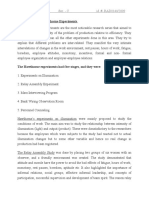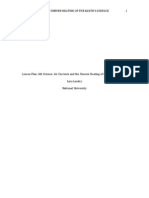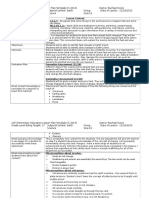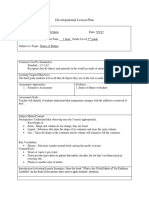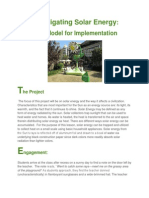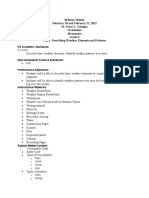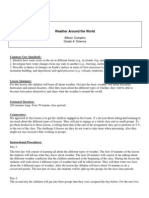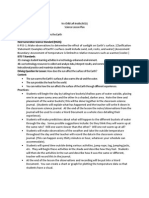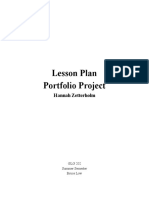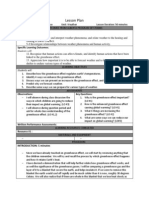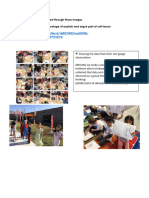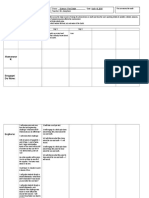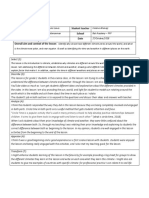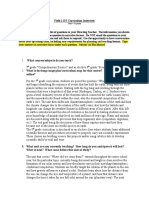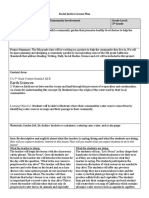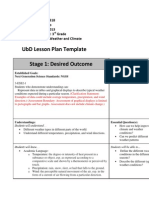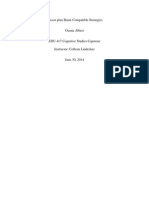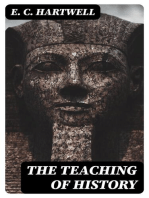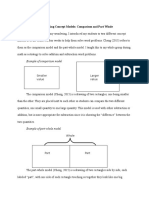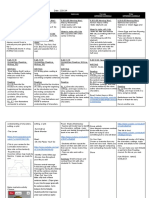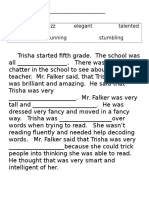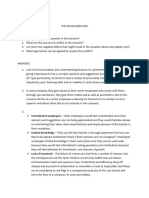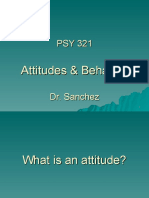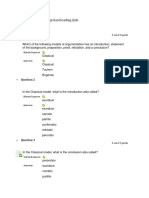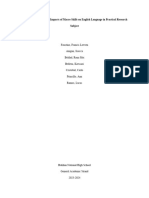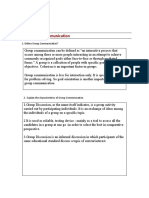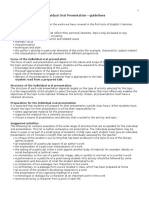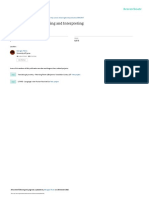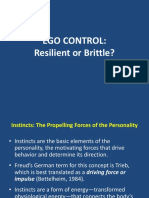USF Elementary Education Lesson Plan Template (S 2016) 2 Gr. WC
USF Elementary Education Lesson Plan Template (S 2016) 2 Gr. WC
Uploaded by
api-308910909Copyright:
Available Formats
USF Elementary Education Lesson Plan Template (S 2016) 2 Gr. WC
USF Elementary Education Lesson Plan Template (S 2016) 2 Gr. WC
Uploaded by
api-308910909Original Title
Copyright
Available Formats
Share this document
Did you find this document useful?
Is this content inappropriate?
Copyright:
Available Formats
USF Elementary Education Lesson Plan Template (S 2016) 2 Gr. WC
USF Elementary Education Lesson Plan Template (S 2016) 2 Gr. WC
Uploaded by
api-308910909Copyright:
Available Formats
USF Elementary Education Lesson Plan Template (S 2016)
Grade Level Being Taught: Subject/Content: Science Group Size:
2nd gr.
WC
What Standards (national
or state) relate to this
lesson?
Essential Understanding
Objectives- What are you
teaching?
Name: Michaela Rich
Date of Lesson: Jan. 27, 2016
Lesson Content
SC.2.E.7.1: Compare and describe changing patterns in nature that repeat themselves,
such as weather conditions including temperature and precipitation, day to day and
season to season.
SC.2.E.7.2: Investigate by observing and measuring, that the Sun's energy directly and
indirectly warms the water, land, and air.
Students will understand and be able to describe patterns in nature, how those patterns
change, and how they repeat.
Students will observe and understand that the sun directly warms a cup of soil, a cup of
water, and the air.
Students will be able to predict what will happen to a cup of soil, a cup of water, and the
air when left in the sun for one hour.
Students will be able to practice their measurement skills when reading a thermometer
and recording the temperature of the soil, water, and air in degrees (Fahrenheit).
Rationale
Evaluation Plan- How will
you know students have
mastered your objectives?
What Content Knowledge
is necessary for a teacher
to teach this material?
What background
knowledge is necessary for
Students will be able to practice their inquiry skills through prediction, measurement, and
observations.
I am teaching this lesson because students need to understand the basic inquiry skills
when it comes to science experiments. Students need to practice making predictions
because this skill is also used in reading. Students will be learning about different
patterns in nature, and this will be a hands on activity for them to observe and measure
such patterns. I am starting with predictions because it aligns with the constructivist
theory. Students make predictions based on their prior knowledge, so this will help me
understand what the students already know about nature patterns with temperature.
Students will have the chance to write down their predictions and share them with the
class. I will record their predictions on the board. Upon observing the experiment,
students will be required to record their observations onto a chart on a worksheet
provided, along with a couple assessment questions.
In order to teach this lesson, I must know that soil will heat up the quickest and have the
highest temperature, followed by water, and then the air. I
Students should know that the sun emits energy that heats the earth. They should be
able to know that their surface temperature would be hotter if they were standing in the
USF Elementary Education Lesson Plan Template (S 2016)
Grade Level Being Taught: Subject/Content: Science Group Size:
2nd gr.
WC
Name: Michaela Rich
Date of Lesson: Jan. 27, 2016
a student to successfully
meet these objectives?
What misconceptions
might students have about
this content?
sun for an hour versus standing in the shade for an hour.
Teaching Methods
5 Es
Students may think that water or air will be hotter than soil after being left in the sun for
an hour, but that is a part of making a prediction. Students may also read the
temperature in Celsius and think that the temperatures are much colder than they really
are.
Lesson Implementation
Step-by-Step Plan
(What exactly do you plan to
do in teaching this lesson? Be
thorough. Act as if you needed
a substitute to carry out the
lesson for you.)
Where applicable, be sure to
address the following:
What Higher Order
Thinking (H.O.T.) questions
will you ask?
How will materials be
distributed?
Who will work together in
groups and how will you
determine the grouping?
How will students
transition between
activities?
Engage
Explore
Explain
Extend
Evaluate
Social Constructivism- turn and talk
Constructivist theory- letting students predict using their prior knowledge
Time
Who is
Each content area may require a different step-by-step format. Use
responsibl whichever plan is appropriate for the content taught in this lesson.
e (Teacher For example, in science, you would detail the 5 Es here
or
(Engage/Encountering the Idea; Exploring the Idea;
Students)? Explanation/Organizing the Idea; Extend/Applying the Idea;
Evaluation).
5-10
minutes
5 minutes
Engage/Explore:
Display an empty glass with water, and a glass with soil.
Ask students, How can I measure the temperature of these two
glasses?
Students should respond with thermometers
Place a thermometer in each glass.
Ask students, What do you think will happen to the temperature of
each glass if placed in direct sunlight? RECORD answers on the
board.
Review the directions on the Inquiry Flipchart:
USF Elementary Education Lesson Plan Template (S 2016)
Grade Level Being Taught: Subject/Content: Science Group Size:
2nd gr.
WC
What will you as the
teacher do?
What will the students do?
What student data will be
collected during each
phase?
What are other adults in
the room doing? How are
they supporting students
learning?
What model of co-teaching
are you using?
5-10
minutes
5-10
minutes
5 minutes
Name: Michaela Rich
Date of Lesson: Jan. 27, 2016
1. Put one thermometer in the cup of water and one in the cup of
soil
2. Put the cups in a sunny spot. Lay the third thermometer next to
the cups. Wait about 1 hour.
3. Measure the temperature of the soil, water, and air. Record and
compare the temperatures, as well as compare the results to the
predictions on the board.
4. Compare observations with the class.
Q: What are you measuring in this activity?
A: Measuring the temperature of the air, water, and soil after time.
Q: Should the temperatures on all three thermometers be the same
before you begin the activity? Explain.
A: Yes, they need to be the same so I can compare what happens to
them after they are left in the sun.
Q: What do you think may cause the temperatures on the
thermometers to change?
A: Heat from the sun may change the temperature.
Q: Why do you have to compare the temperatures on all three
thermometers at the end of the activity?
A: I have to compare them to see if the air, water, and soil were
affected the same or differently by the suns heat.
Explain:
Go over the table in which students will be recording their data.
Once they record, tell them to make conclusions about the data
they have collected. Be specific. They should conclude that the sun
heats water, air, and soil differently.
Extend/Evaluate:
Q: How does the sun heat soil, air, and water differently? How do
you know?
A: Each had a different temperature. I know this because I measured
the temperatures on the thermometers.
Q: What other questions can you ask about the suns heat?
USF Elementary Education Lesson Plan Template (S 2016)
Grade Level Being Taught: Subject/Content: Science Group Size:
2nd gr.
WC
What will you do if
What will you do if
Meeting your students
needs as people and as
learners
Accommodations (If
Name: Michaela Rich
Date of Lesson: Jan. 27, 2016
A: Does the sun heat things more in the morning or in the
afternoon? Does the sun heat things differently in different seasons?
a student struggles with the content?
Pair them with a student who has a full understanding of how to predict, what steps we
will take, and how we will record the data.
a student masters the content quickly?
Ask that they help a student who may be struggling.
Have the student predict what would happen if the soil, water, and air were in the shade
instead of the sun
If applicable, how does this lesson connect to the interests and cultural
backgrounds of your students?
Students have not learned that the sun heats objects, but have been able to observe it
on their own. Since students enjoy experiments and hands-on activities, this activity will
pertain to those interests.
If applicable, how does this lesson connect to/reflect the local community?
Students will be able to understand why a lot of parks and playgrounds offer ample
amounts of shade for children to play in.
Students will know why the rooms in their house that face the sun are warmer than the
rooms that face the shade.
How will you differentiate instruction for students who need additional
challenge during this lesson (enrichment)?
I will ask these students to predict what will happen if:
The cups are left in the sun for longer
The cups are left in the sun in the morning versus the afternoon
The cups are left in the shade
The cups had more water and soil in them and how that would change the outcome
I will also ask them if they predict the top will be warmer than the bottom of the cup, and
vice versa.
How will you differentiate instruction for students who need additional
language support?
Hands on activities will assist those who need language support, even though there are
no students in my class who need the support.
Diagrams on the worksheet.
Turn and talks throughout the lesson.
G.S.- This student needs constant redirection, so when I am instructing the class I will
USF Elementary Education Lesson Plan Template (S 2016)
Grade Level Being Taught: Subject/Content: Science Group Size:
2nd gr.
WC
needed)
Materials
Name: Michaela Rich
Date of Lesson: Jan. 27, 2016
walk around him so that he knows I am watching him and to make it easier for him to
focus.
N.M.- This student cannot pay attention to anything for more than 5 seconds, so I will pair
him with a well-behaved student that can motivate him to listen and keep up with the
writing portion of the assignment. If this is not effective, he will have time later in the day
to finish the writing portion.
1 cup of soil
1 cup of water
3 thermometers
21 worksheets
You might also like
- The Five Stages of Hawthorne ExperimentsDocument2 pagesThe Five Stages of Hawthorne ExperimentsPrince Hiwot Ethiopia100% (14)
- SciencelessonplanDocument13 pagesSciencelessonplanapi-249426288No ratings yet
- CT Observ 2 GravityDocument3 pagesCT Observ 2 Gravityapi-300485205No ratings yet
- Lesson Plan: 6th Science: Air Currents and The Uneven Heating of The Earth's SurfaceDocument9 pagesLesson Plan: 6th Science: Air Currents and The Uneven Heating of The Earth's SurfaceLara LandryNo ratings yet
- MAT 671 Assignment 4.2 Air Currents and The Uneven Heating of The Earth's SurfaceDocument9 pagesMAT 671 Assignment 4.2 Air Currents and The Uneven Heating of The Earth's SurfaceLara LandryNo ratings yet
- Lesson Plan: 6th Science: Air Currents and The Uneven Heating of The Earth's SurfaceDocument9 pagesLesson Plan: 6th Science: Air Currents and The Uneven Heating of The Earth's SurfaceLara LandryNo ratings yet
- Sun Day 5Document3 pagesSun Day 5api-272178501No ratings yet
- Ede Connection Lesson Day 2Document11 pagesEde Connection Lesson Day 2api-264902446No ratings yet
- Edu 356 - Science lp2Document5 pagesEdu 356 - Science lp2api-402544125No ratings yet
- Erosion Lesson PlanDocument4 pagesErosion Lesson Planapi-297180060No ratings yet
- Mathematics and Science Sample Unit Plan Driving QuestionDocument10 pagesMathematics and Science Sample Unit Plan Driving Questionapi-197811218No ratings yet
- USF Elementary Education Lesson Plan Template (S 2014)Document5 pagesUSF Elementary Education Lesson Plan Template (S 2014)api-283799653No ratings yet
- Lesson Plan StormsDocument5 pagesLesson Plan Stormsapi-240398450No ratings yet
- Science Day5Document4 pagesScience Day5api-339309940No ratings yet
- 3rd Grade Level Heat Observation LessonDocument2 pages3rd Grade Level Heat Observation Lessonapi-288906251No ratings yet
- Earthquakes Lesson PlanDocument10 pagesEarthquakes Lesson Planapi-313445058No ratings yet
- Kelas 5 Tema 6 Sub Tema 1Document47 pagesKelas 5 Tema 6 Sub Tema 1trihandayani89No ratings yet
- Weather and Seasons Lesson PlanDocument4 pagesWeather and Seasons Lesson Planapi-432453037No ratings yet
- Investigating Solar EnergyDocument5 pagesInvestigating Solar Energyapi-251642500No ratings yet
- Lesson Plan OneDocument6 pagesLesson Plan Oneapi-548145330No ratings yet
- EDUC2220Lesson (Whether)Document4 pagesEDUC2220Lesson (Whether)ohiobballgirl8No ratings yet
- Wvsu Lesson Plan Format: (Updated 1/13)Document11 pagesWvsu Lesson Plan Format: (Updated 1/13)api-251305346No ratings yet
- Lesson Plan 9Document6 pagesLesson Plan 9api-403763884No ratings yet
- No Child Left InsideDocument3 pagesNo Child Left Insideapi-269295912No ratings yet
- Science Thematic Unit On The SeasonsDocument17 pagesScience Thematic Unit On The Seasonsapi-229232124No ratings yet
- Supervsior CT 1Document6 pagesSupervsior CT 1api-337051062No ratings yet
- Integrated Science Education Weather UnitDocument25 pagesIntegrated Science Education Weather Unitapi-254917183No ratings yet
- Taylor Smith Lesson Plan 5Document3 pagesTaylor Smith Lesson Plan 5api-253118707No ratings yet
- Lesson Plans Portfolio-3Document60 pagesLesson Plans Portfolio-3api-661224129No ratings yet
- Science Lesson AnalysisDocument9 pagesScience Lesson Analysisapi-254772783100% (1)
- Lesson Plan Template: Exploring Climate Change (Link To Lesson)Document2 pagesLesson Plan Template: Exploring Climate Change (Link To Lesson)api-508466273No ratings yet
- Grade 5 - Science - Greenhouse Nov 20Document3 pagesGrade 5 - Science - Greenhouse Nov 20api-239568747100% (1)
- Teaching Background Year 3Document6 pagesTeaching Background Year 3api-316789542No ratings yet
- Social Studies UnitDocument26 pagesSocial Studies Unitapi-259869511No ratings yet
- Lesson 3 96Document2 pagesLesson 3 96api-215458326No ratings yet
- Sci Reflection Fall23Document5 pagesSci Reflection Fall23api-604279172No ratings yet
- USF Elementary Education Lesson Plan TemplateDocument17 pagesUSF Elementary Education Lesson Plan Templateapi-298990923No ratings yet
- Weather and The Water Cycle Unit Plan - 1st/2nd GradeDocument19 pagesWeather and The Water Cycle Unit Plan - 1st/2nd Gradeapi-432453037No ratings yet
- Space and The Solar System Lesson PlansDocument17 pagesSpace and The Solar System Lesson Plansapi-265915778No ratings yet
- Ede Connected Lesson Day 1Document8 pagesEde Connected Lesson Day 1api-264902446No ratings yet
- Earth Science Unit Lessons ReflectionDocument7 pagesEarth Science Unit Lessons Reflectionapi-250608665No ratings yet
- Siop Lesson Plan Template-Assignment 3Document3 pagesSiop Lesson Plan Template-Assignment 3api-328381091No ratings yet
- Weekly Lesson Plan: ObjectiveDocument4 pagesWeekly Lesson Plan: Objectiveapi-319495563No ratings yet
- Reflection 1Document1 pageReflection 1api-310794656No ratings yet
- Antes 408 3-DayfieldreflectionDocument6 pagesAntes 408 3-Dayfieldreflectionapi-284899282No ratings yet
- The Secret Garden Lesson PlanDocument3 pagesThe Secret Garden Lesson PlanAna PestanoNo ratings yet
- Field 1 DT Curriculum Interview: Total 33 PointsDocument4 pagesField 1 DT Curriculum Interview: Total 33 PointsAnonymous hpiYvPNo ratings yet
- Lesson Plan 10Document10 pagesLesson Plan 10api-316688512No ratings yet
- Social Justice Unit PlanDocument10 pagesSocial Justice Unit Planapi-404422607No ratings yet
- Lesson Internet PlanDocument4 pagesLesson Internet Planapi-340962329No ratings yet
- Energy From The Sun: Strand Topic Primary SOLDocument6 pagesEnergy From The Sun: Strand Topic Primary SOLPerfectoCabalquintoNo ratings yet
- Lesson Planning Form For Accessible Instruction - Calvin College Education ProgramDocument5 pagesLesson Planning Form For Accessible Instruction - Calvin College Education Programapi-337267647No ratings yet
- Moon Phases LPDocument5 pagesMoon Phases LPapi-214194136No ratings yet
- Lesson Plan Critique NewDocument6 pagesLesson Plan Critique Newapi-311883715No ratings yet
- Mceduc 353 SciencelessonplanDocument10 pagesMceduc 353 Sciencelessonplanapi-242421771No ratings yet
- Murdock Butler Mini-Lesson PlansDocument3 pagesMurdock Butler Mini-Lesson Plansapi-329772021No ratings yet
- Lesson One For Science UnitDocument5 pagesLesson One For Science UnitLisaNo ratings yet
- Moon Phases Lesson PlanDocument9 pagesMoon Phases Lesson Planapi-252986972No ratings yet
- Lesson Plan BrainDocument9 pagesLesson Plan Brainapi-256038523No ratings yet
- Lesson Plan 1 Electromagnetic SpectrumDocument7 pagesLesson Plan 1 Electromagnetic Spectrumapi-296964326No ratings yet
- 4 AsecondDocument9 pages4 Asecondapi-308910909No ratings yet
- Week252 29Document6 pagesWeek252 29api-308910909No ratings yet
- VocabularyDocument1 pageVocabularyapi-308910909No ratings yet
- 2 11 Aunt SusanDocument4 pages2 11 Aunt Susanapi-308910909No ratings yet
- LEARNING FRENCH AS A SECOND LANGUAGE: CHALLENGES FOR A NATIVE ENGLISH SPEAKER - Adigwe Joseph Chinedu and Anukwu Anthonia .UDocument9 pagesLEARNING FRENCH AS A SECOND LANGUAGE: CHALLENGES FOR A NATIVE ENGLISH SPEAKER - Adigwe Joseph Chinedu and Anukwu Anthonia .UFrancis AbuludeNo ratings yet
- 12 - Activity in QualityDocument2 pages12 - Activity in QualityElnel TolibasNo ratings yet
- Program Control Services Senior Analyst - Accenture Solutions Pvt. LTD., NoidaDocument1 pageProgram Control Services Senior Analyst - Accenture Solutions Pvt. LTD., NoidaStutiBanthiyaNo ratings yet
- PROF ED 7 - Principles and Methods of TeachingDocument18 pagesPROF ED 7 - Principles and Methods of TeachingCharissa Eniva CalingganganNo ratings yet
- Attitudes BehaviorDocument65 pagesAttitudes BehaviorEdwin SinghNo ratings yet
- Classical, Toulmin, Rogerian Reading QuizDocument8 pagesClassical, Toulmin, Rogerian Reading QuizRocket FireNo ratings yet
- Assessing Learners - The Impacts of Macro Skills On English Language in Practical Research SubjectDocument11 pagesAssessing Learners - The Impacts of Macro Skills On English Language in Practical Research SubjectMordana MannNo ratings yet
- Communication ModelsDocument30 pagesCommunication Modelsmark bendanoNo ratings yet
- Componential Analysis + ExercisesDocument3 pagesComponential Analysis + ExercisesLy KhánhNo ratings yet
- Group CommunicationDocument3 pagesGroup CommunicationKartikNo ratings yet
- CHAPTER 2 Allyn and Bacon Guide To WritingDocument9 pagesCHAPTER 2 Allyn and Bacon Guide To WritingJulianne Descalsota LegaspiNo ratings yet
- Movie Review: Psychology MPU 2063Document15 pagesMovie Review: Psychology MPU 2063Yogendran GanesanNo ratings yet
- Henry Hippo TestDocument4 pagesHenry Hippo TestAndrea Villegas FigueroaNo ratings yet
- Islamic Management - Functions of 'Aqidah (Believe) in ManagementDocument30 pagesIslamic Management - Functions of 'Aqidah (Believe) in ManagementMohd Fuad Mohd Salleh, UniselNo ratings yet
- Business OperationsDocument12 pagesBusiness OperationskijeseNo ratings yet
- Elaine's EAP SessionsDocument6 pagesElaine's EAP SessionsNetanya SyallomNo ratings yet
- The Group Begins ReportDocument70 pagesThe Group Begins ReportJeremiah Magcalas100% (2)
- IOP InstructionsDocument7 pagesIOP InstructionsJuan José TorresNo ratings yet
- Pp. PP.: Daily ActivitiesDocument3 pagesPp. PP.: Daily ActivitiesRowena Sta MariaNo ratings yet
- Soc Sci Art Appreciation HumanitiesDocument38 pagesSoc Sci Art Appreciation HumanitiesJane PadillaNo ratings yet
- Adve of Manner-Frequently AdvDocument2 pagesAdve of Manner-Frequently AdvKaren AndradeNo ratings yet
- Contact: AddressDocument1 pageContact: Addressapi-476637252No ratings yet
- Does Your Leadership Style Scare Your EmployeesDocument2 pagesDoes Your Leadership Style Scare Your EmployeesRuchikaNo ratings yet
- Encoding - Decoding Model of Communication - WikipediaDocument9 pagesEncoding - Decoding Model of Communication - WikipediaMd Intaj AliNo ratings yet
- Parallel Texts in Translating and InterpretingDocument14 pagesParallel Texts in Translating and InterpretingOu SsNo ratings yet
- Russell Jose Diez 04Document24 pagesRussell Jose Diez 04Fernando M.No ratings yet
- Bhavya Gupta MbaDocument51 pagesBhavya Gupta MbaAbilash AjithNo ratings yet
- Rat Man Case Study by Sigmund Freud (10608140)Document1 pageRat Man Case Study by Sigmund Freud (10608140)YerenicaNo ratings yet
- Ego ControlDocument30 pagesEgo ControlNgan NguyenNo ratings yet
